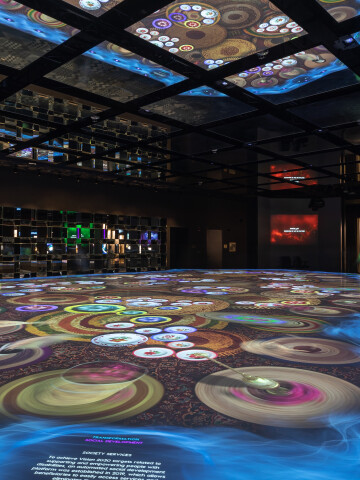
A unique and interactive experience for the Saudi Arabian Pavilion at Expo 2020 Dubai
January 3, 2021
The Universal Expositions represent the world's greatest example of diversity, innovation, and cooperation between nations.
For 170 years, they have provided a platform to showcase the greatest advances that have shaped the world we live in today, as well as the achievements and challenges in each country in areas such as culture, science, art, commerce, and sustainability.
Furthermore, these unique celebrations have a very positive impact on the economic, social, and cultural development of the cities that host them, leaving a lasting legacy for their inhabitants and visitors.
The last one held, Expo 2020 in Dubai, was the first located in the Middle East, Africa, and South Asia region, making it one of the most important in history. For six months, it brought together more than 192 countries in its facilities, received nearly 11 million in-person visitors and more than 100 million attended virtually.
Between History and the Future
Among the numerous national pavilions that took place at the Expo, the Saudi Arabian pavilion, designed by the renowned architect Boris Micka, was one of the largest and most spectacular at the event.

With an area of 13,059 square meters and a height of six floors, this pavilion was erected as an incomparable space of the latest technology, through which to show the identity, history, heritage, development, and steps towards the future of the Saudi Kingdom.
The building hub was the so-called Discovery Centre, an area where the architectural project placed a huge interactive table (one of the most innovative and surprising attractions of the Expo) whose shape resembled that of the host country, and allowed visitors to explore important national landmarks.

It was a collaborative effort where Kraftwerk Living Technologies designed and implemented the entire HW system. PASOSLARGOS ANIMATION, whose members are now part of SNGULAR, created and animated the central video. SNGULAR developed and deployed the interactivity system for 42 simultaneous stations, designed the animated particle system for the UI of these stations, and interconnected 7 servers with Unreal N-Display. All of this was carried out under the direction of BMA.
The design and development of this innovative interactive experience was a great technical and artistic challenge, since it was something that had not been done before and required great quality and reliability.
Furthermore, the time available to implement the project was very limited in order for the opening date of the Expo to be met.
Complex Challenges and Pandemics
Due to the difficulty in finding a company that was capable of combining the artistic and technical skills necessary to meet the architectural requirements of the pavilion, the studio in charge of its execution contacted SNGULAR.
From a technical point of view, the project was very complex, largely due to the difficulty in sizing the required hardware and accommodating the IT infrastructure needs. On the other hand, the inability to replicate the interactive table in the SNGULAR offices forced the team to regularly travel to a work site thousands of kilometers away. In addition to the distance, the site was constantly being transformed and was accompanied by heavy machinery. All the nuances of the site were coupled with complicated access due to security measures put into place to safeguard the integrity of the workers.
In the artistic section, the solution had to pass a series of specific tests, which guaranteed that the level could meet the demanding artistic standards required, a common requirement in projects of this magnitude.
As if there were not enough complications, the emergence of the COVID-19 pandemic provided an additional impediment, since the development of the Expo was practically paralyzed, with all the logistical problems that this entailed.
According to Daniel Martínez de Leiva, Project Manager at SNGULAR, "A development of such an intricate nature such as this is normally subject to complications that require extremely meticulous logistics, detailed planning and very tight execution deadlines".

A Fusion of Art and Technology
As already mentioned, the centerpiece of the Discovery Center was a high-tech interactive table that displayed sequences about Saudi life, and which was designed to be seen as a work of art, with all that entails.
This device had dimensions of 12x10 meters and had 42 interactive stations. At each station, visitors could simultaneously select different types of content and see them displayed on the surface of the table using 20 overhead 4K projectors (which ensured maximum image quality), that were linked to 7 servers. All the servers were interconnected to provide a continuous and homogeneous interactive experience, without jumps or scrolling of images.
The projection lasted 10 minutes and covered seven main themes about life in Saudi Arabia: Geography and Nature, Cities of the Future, Society, Energy, Tourism, Culture, and Religion. All of them included a host of dynamic elements, user interfaces with particle effects and a high degree of realism.
An element of this type, in addition to all the technological complexity of the endeavor, contributed to an extra artistic challenge. Since the projections were made from a higher plane, special care had to be taken to ensure that they were not perceived as deformed two-dimensional elements, since the aim was to achieve a certain volume and appropriate proportions, as if one were observing a model.
This problem can usually be resolved using an artistic resource that is hundreds of years old, anamorphosis. This perspective effect deforms an image so that it can only be recognized from a specific point of view, in which the element takes on a proportionate and clear shape.
However, the table represented a giant canvas and dozens of viewing spots. This detail was one of the most important issues to be addressed in the installation, since the anamorphosis had to be applied to all the visual content, so that it could be seen correctly from anywhere on the perimeter of the table, where the interactive stations were located.
This proved to be extremely challenging and required the contribution of diverse profiles of digital artists, including illustrators, 3D graphics experts and animators. All of whom generated enormous data transfers in both English and Arabic, as well as an impressive number of renders. Such were the dimensions of the project that we had to develop our own content manager or CMS to store all these materials.
On the other hand, the table featured an interactive area spread across 42 independent and simultaneous stations, starting from the outer edge of the table and extending approximately one meter towards its center. In this area, dynamic menus were displayed, providing access to comprehensive and detailed information on various topics.
In order to complement all the content offered by the interactive table, a series of pods or dedicated projections were also displayed on the surrounding walls, where the pavilion staff could offer additional multimedia information (over a thousand data points with images and videos) from a tablet. With this addition and increasing access for a greater number of visitors, the experience of the pavilion was completed. Each room was given enormous versatility when it came to personalizing the content that was served to each of them.
"The result, after about 9 months of development, plus an additional 8 due to the COVID-19 stoppage, and 25 people working on the project (16 simultaneously), was a unique and surprising interactive experience, which managed to capture the interest of visitors, media, and all types of international organizations", says Martínez de Leiva.
Global Impact
The Saudi Arabian pavilion has won numerous international awards. Notable awards include the prestigious Award for Best XL Pavilion, awarded by US EXHIBITOR Magazine and the two BIE Awards, presented by The UAE Innovates Awards.
It also holds three Guinness Records (including the largest surface area of LED screens and the largest surface area of interactive projection). It also holds the title of the most visited Expo pavilion, hosting more than 4 million visitors over the course of the exposition.
For its respective part, the interactive table project developed by SNGULAR has received significant praise and recognition for its quality, originality, and innovation. The project represents a successful before and after for the team at an international level in terms of large-format interactive installations. Among the international awards it has received are the Red Dot Design Awards 2022, the IF Design Awards 2022, and the Silver A'Design & Competition Awards 2022.
It is important to note that most of the pavilions are dismantled at the end of the event. However, some countries choose to build permanent buildings that help them promote their culture and take a leap forward economically. This is the case of Saudi Arabia, a country that experiences a lot of tourism, and wanted to take advantage of the opportunity to have its own space to showcase its identity, potential, and vision for the future.
As Daniel Martínez de Leiva comments, "This project was a feat of collaboration and creativity that surpassed all technical and logistical limitations. Despite the challenges, we delivered a work of art that left a strong impression, surpassing any expectations. “It was proof of what a committed and passionate team can achieve when faced with adverse circumstances and limited time".
Our latest news
Interested in learning more about how we are constantly adapting to the new digital frontier?

Insight
December 26, 2025
Ferrovial improves heavy construction efficiency with Connected Works

Insight
October 17, 2025
How to transform Customer Experience dashboards into intelligent decisions

Insight
September 9, 2025
From Cost Center to Competitive Advantage: Discover the New ROI of Customer Service

Insight
July 15, 2025
Elevating Customer Experience: The Vital Integration of Customer Service, Marketing, and Sales
